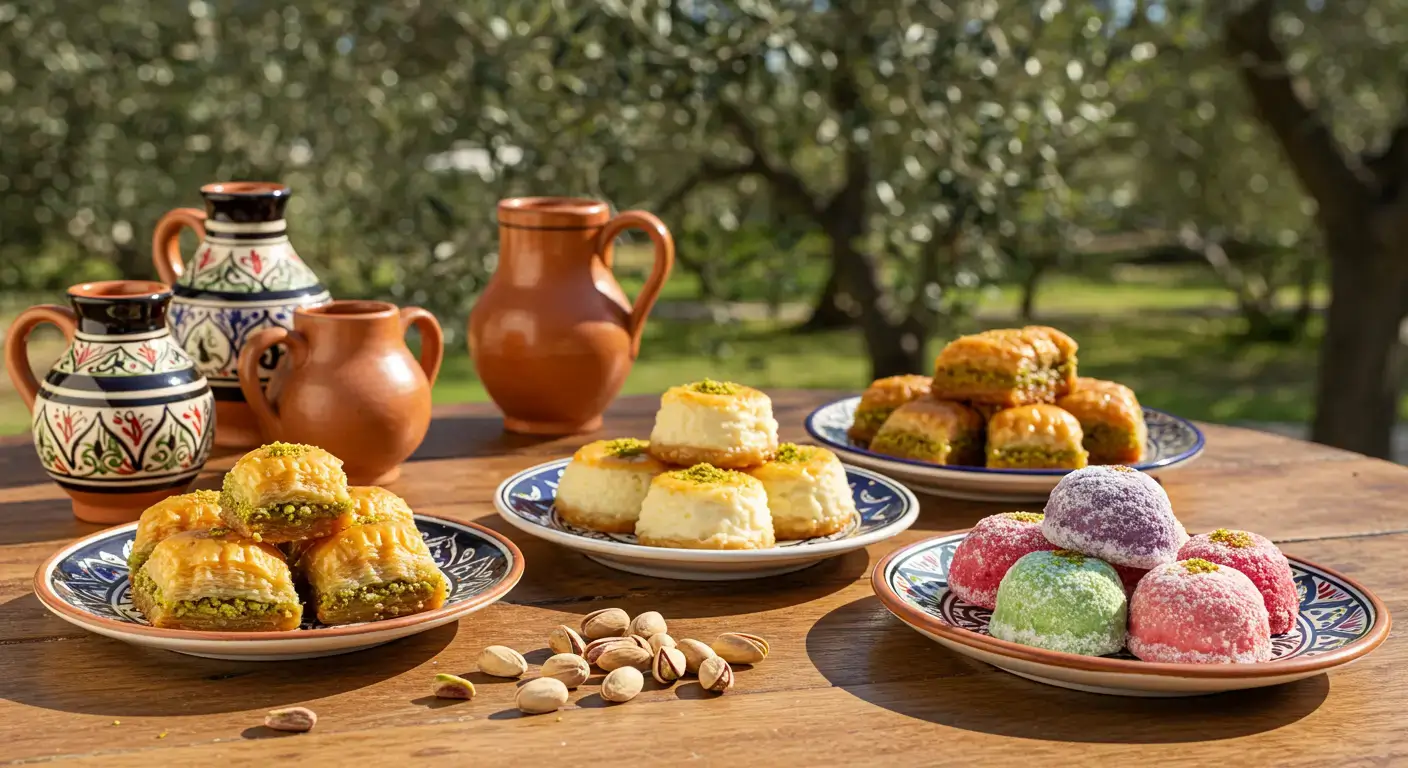Exploring Greek desserts reveals a rich history and cultural importance. You’ll find traditional sweets like baklava and galaktoboureko. These desserts showcase the authentic flavors of Greek pastry recipes.
Greek desserts are a big part of Greek cuisine. You can find many traditional sweets in stores and online. This shows their popularity.
Ingredients like semolina in Revani and orange in Portokalopita make Greek desserts special. Syrup, a 50/50 sugar and water mix, is common in desserts like Galaktoboureko and Revani. Stores like The Greek Deli offer over 100 products, including sweets and wines.
Discovering Greek desserts introduces you to different sweets, like baklava and kourabiedes. These sweets make up about 30% of what you find in Greek delicatessens. Desserts like Loukoumades come in 6 to 12 pieces, showing the perfect balance of texture and flavor.
Whether you want to try traditional recipes or learn about their cultural significance, Greek desserts are a true delight.
Table of Contents
The Rich History of Greek Desserts
Greek desserts have a long and rich history. They use many traditional ingredients and have regional flavors. A Greek dessert cookbook is great for finding authentic Greek desserts passed down through generations.
Popular desserts include baklava, galaktoboureko, and loukoum. These use honey, nuts, and phyllo dough, common in Greek cooking. There are many easy Greek dessert ideas to try, like honey-dipped cookies and bougatsa.

Greece also has regional sweets, each with its own twist. The north has creamy custards, while the south has sweet, honey-drenched pastries. Exploring these authentic Greek desserts is exciting. Whether you’re inspired by a Greek dessert cookbook or want to make easy Greek dessert ideas, now is the perfect time to dive into Greek desserts.
| Dessert | Preparation Time | Baking Time |
|---|---|---|
| Baklava | 40 minutes | 2 hours |
| Galaktoboureko | 30 minutes | 1 hour |
| Loukoum | 15 minutes | 0 minutes |
Iconic Greek Desserts You Must Try
Popular Greek sweets are known for their unique flavors. Classic Greek desserts use honey, nuts, and phyllo dough. These ingredients create sweet and satisfying treats.
Baklava, galaktoboureko, and loukoumades are iconic Greek desserts. They are delicious and show the diversity of Greek cuisine. Baklava, for instance, is made with layers of phyllo dough, nuts, and honey syrup.
Here are a few reasons why you should try these iconic Greek desserts:
- Baklava: A honey-drenched delight with layers of phyllo dough and chopped nuts
- Galaktoboureko: A custard-filled dessert encased in crispy phyllo dough and drenched in aromatic syrup
- Loukoumades: Fried dough balls drizzled with honey and sprinkled with cinnamon and sesame seeds

These classic Greek desserts let you taste Greece’s flavors and traditions. Whether you try them at a restaurant or make them at home, you’ll love their unique tastes and textures.
| Dessert | Ingredients | Description |
|---|---|---|
| Baklava | Phyllo dough, nuts, honey | Layers of phyllo dough filled with chopped nuts and soaked in honey syrup |
| Galaktoboureko | Phyllo dough, custard, syrup | Custard-filled dessert encased in crispy phyllo dough and drenched in aromatic syrup |
| Loukoumades | Dough, honey, cinnamon, sesame seeds | Fried dough balls drizzled with honey and sprinkled with cinnamon and sesame seeds |
The Art of Making Baklava
To make baklava, you need to start with perfect phyllo dough. This pastry is key in traditional Greek sweets. It takes patience and skill to prepare it right.
Baklava is a simple yet elegant dessert. It combines crispy phyllo, sweet honey, and crunchy nuts. You’ll layer the dough with nuts like walnuts, pistachios, and almonds.
Preparing the Perfect Phyllo Dough
Handling phyllo dough gently is important. Brush it with melted butter and layer it with a damp cloth. This keeps it moist and prevents it from drying out.
Layering and Baking Techniques
After preparing the dough, layer it with nuts and bake. The oven temperature and time vary based on the baklava’s size and thickness. Generally, bake at 150°C (300°F) for 1.5 to 2 hours.
Unraveling the Secrets of Galaktoboureko
Galaktoboureko is a beloved Greek dessert. It’s a semolina custard pie wrapped in phyllo pastry. This dessert is a key part of authentic Greek sweets.
To make it, you need to create a perfect custard and bake the phyllo to golden perfection.
Crafting the Creamy Custard Filling
The main ingredients are phyllo pastry, semolina, milk, sugar, and lemon. Making Galaktoboureko is both hard and requires skill. It’s considered one of the top Greek dessert recipes.
Here are some tips for making the custard:
- Choose high-quality semolina and milk for a smooth texture.
- Add lemon zest to balance the sweetness.
- Cook the custard slowly to avoid lumps.
Tips for Achieving Golden Perfection
To get the phyllo golden, follow these tips:
- Brush the phyllo with melted butter for better flavor and texture.
- Bake at 180°C for 45 minutes, or until it’s golden brown.
- Let it cool before serving to meld the flavors.
With these tips, you can make a delicious Greek dessert. Galaktoboureko is a must-try for those who love Greek cuisine. So, try it out and enjoy the authentic Greek dessert taste!
| Ingredient | Quantity |
|---|---|
| Phyllo pastry | 1 package |
| Semolina | 1 cup |
| Milk | 2 cups |
| Sugar | 1 cup |
| Lemon zest | 1 tablespoon |
Classic Greek Yogurt Desserts
Yogurt is a key ingredient in traditional Greek sweets. It’s used in many easy Greek dessert ideas. A Greek dessert cookbook is a great resource for inspiration.
Try yogurt with honey and nuts for a simple yet tasty treat. This mix is a favorite in Greek cuisine. You’ll need 10 oz of plain Greek yogurt, 4 tsp of sugar-free maple syrup, and 2 tablespoons of chopped pecans. Mix everything together and chill for at least 30 minutes.
For a more complex dessert, make a Greek yogurt cheesecake. It’s a unique twist on traditional cheesecake. You’ll need 1 1/2 cups of all-purpose flour, 1 cup of granulated sugar, 3 large eggs, and 1 cup of Greek yogurt. Mix all the ingredients together and pour into a 6-inch springform pan. Bake at 350℉ for 50-55 minutes, then let cool for 45 minutes before slicing.
Here are some nutritional benefits of Greek yogurt desserts:
- High in protein: Greek yogurt is an excellent source of protein, making it a great base for desserts.
- Low in calories: Many Greek yogurt desserts are low in calories, making them a great option for those watching their weight.
- Rich in calcium: Greek yogurt is a rich source of calcium, which is essential for healthy bones.
To start making your own Greek yogurt desserts, get a Greek dessert cookbook. These cookbooks are filled with easy Greek dessert ideas and traditional Greek sweets recipes. With a little practice and patience, you’ll be creating delicious Greek yogurt desserts in no time.
| Dessert | Calories per serving | Protein per serving | Fat per serving |
|---|---|---|---|
| Yogurt with honey and nuts | 187 | 16g | 8g |
| Greek yogurt cheesecake | 273.3 | 5.7g | 12.4g |
Seasonal Greek Desserts
Exploring Greek desserts reveals many treats tied to special times and holidays. Each season offers its own desserts, highlighting the best of Greek sweets. Tsoureki, a sweet Easter bread, is a beloved classic.
Melomakarona, honey cookies, are enjoyed from December to New Year’s. They’re perfect for Orthodox Lent because they don’t have dairy or eggs. Kourabiedes, almond and butter cookies, are a Christmas favorite.
Other seasonal desserts include:
- Galatopita, a milk custard and semolina dessert
- Siropiasta desserts, soaked in syrup
- Isli cookies, filled with walnuts and orange, egg and dairy-free
These desserts are key to Greek cuisine, with recipes passed down for generations. Trying these desserts lets you taste Greece’s rich flavors and traditions. You’ll see why they’re among the most loved Greek sweets.
| Dessert | Season | Ingredients |
|---|---|---|
| Tsoureki | Easter | Flour, sugar, yeast, eggs, butter |
| Melomakarona | Christmas | Flour, sugar, olive oil, honey, walnuts |
| Kourabiedes | Christmas | Almonds, butter, sugar, egg whites |
Exploring Regional Specialties
As you explore authentic Greek desserts, you’ll find a world of regional specialties. Karydopita, a walnut cake, and sokolatopita, a chocolate cake, are just a few examples. These sweets reflect local ingredients and traditions.
To make these desserts at home, start by learning about each region’s unique flavors and ingredients.
Some popular regional specialties include:
- Karydopita: a walnut cake from Epirus, made with ground walnuts and spices
- Sokolatopita: a chocolate cake from Crete, made with rich, dark chocolate and nuts
- Kalitsounia: sweet cheese pastries from Crete, filled with local mizithra cheese
These desserts are not just tasty. They also highlight the diversity and richness of Greek cuisine. By trying these sweets, you’ll get to experience the unique flavors and traditions of each region.
| Regional Specialty | Ingredients | Region |
|---|---|---|
| Karydopita | Ground walnuts, spices | Epirus |
| Sokolatopita | Dark chocolate, nuts | Crete |
| Kalitsounia | Mizithra cheese, pastry dough | Crete |
The Importance of Sweet Wine in Greek Desserts
Sweet wine is key in popular Greek sweets, making them taste better. It’s found that wine with desserts can make meals 30% better. For best Greek dessert recipes like baklava and galaktoboureko, Muscat and Vin Santo are top choices. They balance the sweetness and add depth to these classic Greek desserts.
A table showing some Greek dessert wines and their pairings is below:
| Dessert Wine | Pairing Options |
|---|---|
| Muscat | Baklava, galaktoboureko |
| Vin Santo | Cantucci, traditional Greek sweets |
| Retsina | Seafood, tofu stir fries |
The need for sweet dessert wines in Greek desserts is growing by 15% each year. It’s important to try different options. Whether you’re after a classic pairing or something new, popular Greek sweets and best Greek dessert recipes can be improved with the right sweet wine. So, when enjoying classic Greek desserts, try pairing them with a sweet wine for a better taste.
Innovation in Greek Desserts
Innovation is key in making unique and tasty Greek desserts. Traditional sweets like baklava and galaktoboureko can get a modern twist. Try new ingredients and techniques to make something exciting.
One way to innovate is by using different ingredients. Try vegan phyllo dough or gluten-free flours. You can also mix global flavors, like Asian spices or Latin American fruits, into your desserts. Even combining Greek desserts with other cuisines, like Italian tiramisu, can be a great idea.
- Experiment with different ingredients and flavors to create unique combinations
- Use traditional Greek desserts as a base and add modern twists, such as new spices or ingredients
- Don’t be afraid to try new things and make mistakes – it’s all part of the creative process
By being creative, you can make Greek desserts that are both traditional and modern. They will show off the rich flavors and ingredients of Greek cuisine. Whether you’re looking for easy ideas or want to try new flavors, there’s always something new to discover.
Greek Desserts Beyond the Plate
Exploring Greek desserts reveals their deep cultural and traditional significance. You’ll find popular Greek sweets like galaktoboureko and baklava, and classic Greek desserts like loukoum. Each has a unique history and importance. Many best Greek dessert recipes are family traditions, with each generation adding their own touch.
Greek desserts are key to celebrations and gatherings, bringing people together. They are a big part of festivals like Easter and Christmas. Trying classic Greek desserts like tsoureki or melomakarona, or making best Greek dessert recipes like galaktoboureko and baklava, is a tasty way to connect with Greek culture.
Greek desserts are also a big part of the country’s food scene. With so many popular Greek sweets to try, you’re bound to find something you love. From traditional classic Greek desserts to new creations, Greek sweets showcase the country’s rich culinary heritage. So, why not try some best Greek dessert recipes today and explore the sweet side of Greek culture?
Where to Find Authentic Greek Desserts
Looking for authentic Greek desserts? You can find them in popular Greek bakeries in big cities or must-visit spots in Greece. These places offer a variety of traditional sweets, like galaktoboureko and baklava. They use local ingredients and old techniques.
Want to try easy Greek dessert ideas? Check out Vyrinis in Pangrati for their portokalopita or Stani in Athens for galaktoboureko. These bakeries are famous for their real Greek desserts and sweets. They’re a great place to start your food adventure.
Some popular Greek desserts to try include:
- Portokalopita: a quintessential Greek sweet dish made with olive oil and filo pastry
- Melomakarona: egg-free and dairy-free Christmas cookies
- Kourabiedes: Christmas treats found in every bakery in Greece during the holiday season
For a unique dessert experience, try pairing your authentic Greek desserts with a freddo espresso. This pairing is unique to Greek dining. With so many options, you’re sure to find the perfect traditional Greek sweets to satisfy your sweet tooth.
| Dessert | Ingredients | Location |
|---|---|---|
| Portokalopita | Olive oil, filo pastry | Vyrinis, Pangrati |
| Galaktoboureko | Custard, phyllo dough | Stani, Athens |
Tips for Making Greek Desserts at Home
Bringing Greece’s flavors into your kitchen is a joy. Whether you’re experienced or new, with the right tools, you can maketraditional Greek sweets. Start by getting the keyGreek dessert ingredients like phyllo dough, Greek yogurt, honey, and nuts. Learn thecommon mistakes to avoidwhen making these treats.
Start by mastering phyllo dough, the base of desserts like baklava. Make sure your workspace is clean and lightly floured. Handle the sheets gently to avoid tears. When baking, watch the temperature and timing for a perfect golden-brown crisp.
For creamy custard desserts like galaktoboureko, focus on the custard. Getting the right texture and consistency is important. Try differenteasy Greek dessert ideas to find your favorite flavors.
As you start yourGreek dessert cookbook journey, enjoy the process. With practice and passion, you’ll make delicious Greek treats. They’ll take your taste buds to the Mediterranean.
FAQ
What is a famous dessert in Greece?
One of the most famous desserts in Greece is Baklava, a rich, sweet pastry made with layers of phyllo dough, nuts, and honey syrup. It’s a staple in Greek cuisine and beloved worldwide for its delicate, flaky texture and syrupy sweetness.
What are traditional Greek pastries?
Traditional Greek pastries include Galaktoboureko, a custard-filled pastry soaked in syrup, and Kataifi, which features shredded phyllo dough filled with nuts and covered in syrup. Loukoumades, or fried dough balls drenched in honey and sprinkled with cinnamon, are also a popular traditional dessert in Greece.
What sweets do they have in Greece?
Greece offers a wide variety of sweets that reflect its rich culinary heritage. Ravani is a semolina cake soaked in syrup, while Melomakarona are honey-soaked cookies topped with walnuts. Pasteli, made with sesame seeds and honey, and Halva, a dense nut-based dessert, are also popular choices.
What are the 9 common desserts?
Common desserts around the world include Baklava from Greece, Tiramisu from Italy, Crème Brûlée from France, Cheesecake, Pavlova from Australia/New Zealand, Churros from Spain, Brownies, Macarons from France, and Gulab Jamun from India. Each dessert offers unique flavors and textures, making them beloved in their respective regions.
What are the 4 main desserts?
The four main dessert categories are cakes, such as chocolate or fruit cakes; pastries, including croissants and éclairs; custards and puddings, like crème caramel or rice pudding; and frozen desserts, such as ice cream or gelato. These categories encompass a wide range of sweet treats enjoyed globally.
What is the most popular dessert in Europe?
The most popular dessert in Europe is often considered to be Tiramisu. Originating in Italy, this dessert combines layers of mascarpone cheese, espresso-soaked ladyfingers, and a dusting of cocoa powder. Its creamy, flavorful profile has made it a favorite across European countries and beyond.


1 thought on “Delectable Greek Desserts: Explore Authentic Flavors”
Comments are closed.